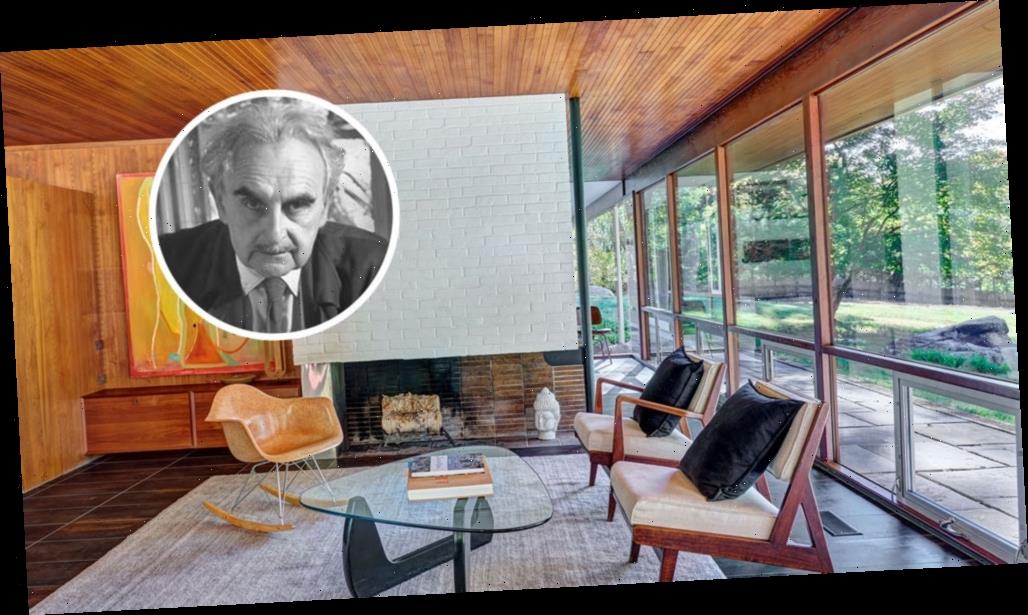In preparing to design Glen House, which maverick architect Richard Neutra completed in Stamford, Conn. in 1960, the designer camped out on the site under a full moon. People tend to think of Neutra as a stern modernist, but in fact, he was a romantic who “felt a desperate commitment to the art,” said architect Joseph Hansen, who worked with him during the ‘60s.
Fifty years after Neutra’s death, many people still feel the pull of the romance of modernist architecture, but only the lucky few get an opportunity to actually live with it. This makes the availability of Glen House something of an event. One of only three residences Neutra completed in Connecticut, the roughly 4,000-square-foot residence presides over a heavily wooded 2.41-acre lot with four bedrooms and 3.5 baths. The asking price is $4.5 million. Featuring an abundance of floor-to-ceiling windows, the house is oriented to the surrounding landscape as if nature were a Broadway show; this is a house that encourages occupants to look outdoors. And, although it feels like the country, it’s just a 50-minute train ride from Manhattan.
A leading proponent of the International Style, Neutra believed in multi-functional spaces that are flexible, adaptable, and easily modified for any kind of life, and the Glen house definitely fills that bill. Rigorously geometric, yet fluid and filled with light, it’s a sleek, simple residence, with a color palette of white, warmly toned wood, and steel.
When the current owners purchased the property in 2005 it was badly in need of restoration, so they collaborated with Joeb Moore + Partners on an extensive restoration and redesign. Their goal wasn’t to make the house resemble the one the Glen family moved into in 1960; rather, they instituted careful interventions based on Neutra’s original vision of the house prior to budget restraints as well as special requests made by the Glen family.
Changes to the house include a master bedroom that’s been enlarged to include a dressing room and an expanded bath with soaking tub. The area calling for the most significant update, however, was the kitchen. Here, Joeb Moore + Partners replaced a partition with a pair of stainless steel columns. Opening up the room in this way is reflective of the way social attitudes about kitchens have changed. During the ‘60s, they were considered places to conceal, store, and support things. Today, the kitchen is a place for display, preparation and culinary performance.
Glen House is often described as the sibling of the renowned Singleton House, which Neutra was concurrently building in the Bel Air neighborhood of Los Angeles. (Singleton House is currently owned by French businessman Francois Pinault, who bought it in late 2012 for $16.5 million from the estate of hair care mogul Vidal Sassoon.) In fact, the houses have distinctly different personalities: Singleton House is all about the pool and the spectacular views, while Glen House is very much a place in the country. Neutra clearly had more than one trick up his sleeve, and he lived a life more complex than is commonly known.
Born into a wealthy family in Vienna in 1892, Neutra served in the First World War, and in 1932 he attempted to move to the Soviet Union to assist in designing housing for workers. (They didn’t want his help.) The hero of Ayn Rand’s young adult novel, “The Fountainhead,” is also said to have been based on Neutra, who was a happily married family man with three sons. (Rand, in fact, lived for a period in a now-demolished villa Neutra built in the San Fernando Valley, in 1935, for director Josef von Sternberg.) When Neutra was informed of Rand’s tribute, he said, “I don’t know where she got her political ideas, but it’s obvious she used me as the model for Howard Roark’s sexuality.” In addition to his architecture savvy, Neutra clearly had a sense of humor, too.
The one-of-a-kind property is listed with Rick Distel at Compass.
Source: Read Full Article
